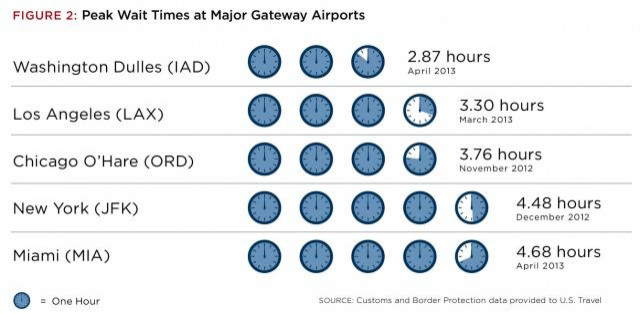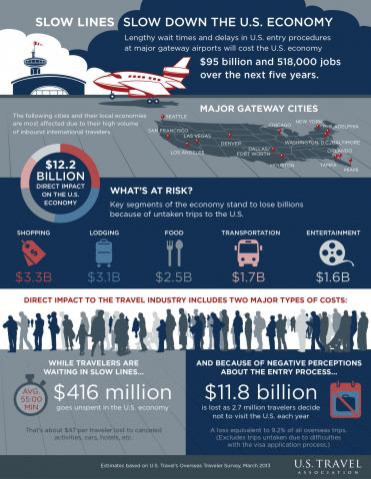The US Border Problem That’s Deterring Millions Of Visitors And Hampering The Travel Industry

What’s the single biggest deterrent that’s keeping millions of international travelers from visiting the United States each year? If you ask the U.S. Travel Association, the answer is simple: U.S. border policies.
In a 36-page report released Wednesday, the national nonprofit trade organization proposed 20 policy changes that it said would address the severe economic consequences that result from the often lengthy wait times experienced by millions of travelers during the U.S. Customs and Border Protection, or CBP, entry process.
“The U.S. welcomed 67 million visitors last year, and far too many of these valued customers spent the first hours of their trip waiting in line at U.S. air ports of entry,” Roger Dow, president and CEO of the U.S. Travel Association, explained. “International travel is a bright spot for the U.S. economy, but long lines and wait times that many experience during entry are deterring millions of potential visitors while our country is working to rebuild its global market share.”
Of the five largest gateway airports, the new report found that Miami (4.68 hours) and New York’s JFK (4.48 hours) had the longest peak wait times, followed by Chicago O’Hare (3.76 hours), Los Angeles (3.30 hours) and Washington Dulles (2.87 hours). The report blamed staffing shortages for the lion’s share of the delays, which it said often resulted in missed connections.
The U.S. has a national goal of welcoming 100 million international visitors by 2021 -- an influx that could add upwards of $250 billion to the economy each year, according to the report. But U.S. Travel believes new resources are critical to improving the ability of CBP officers to process passengers efficiently while attending to every security need.
“The issue is not the CBP officers themselves, whom even delayed travelers regard as competent and hard-working,” Dow noted. “The problems lie in policy and resources, which Congress must address.”
Failure to act on this “solvable problem,” Dow said, would do measurable harm to the U.S. economy as it continues its recovery. In fact, U.S. Travel estimated in the report that the total cost of delaying and deterring visitors would reach $95 billion over the next five years -- dollars it said could be used to support 518,000 American jobs.
Moreover, the report noted that 2.7 million international travelers, or about 9 percent of potential trips, avoid visiting the U.S. altogether each year because of negative perceptions about the entry process. Bringing the initial inspection process down to 30 minutes or less, it found, would result in a surge in visitors that could generate approximately $3.5 billion in positive economic impact and create 24,000 jobs annually.
U.S. Travel accompanied its report with an open letter to Congress co-signed by a diverse representation of travel executives, including the CEOs of NYC & Company, Visit Orlando, Hertz Corporation, Hyatt Hotels, Hilton Worldwide and the American Gaming Association. The letter called for prompt legislative vehicles for reform.
"I join with other travel leaders in calling on Congress to invest in the U.S. entry process so that our international guests feel welcomed from the first moment they enter the country," Jim Abrahamson, CEO of Interstate Hotels & Resorts and national chair of the U.S. Travel Association, stated Wednesday. "Our path to welcoming 100 million or more international travelers every year is paved with reforms to our visa issuance process, our newly established national tourism promotion program and, now, improvements to the U.S. entry process."
U.S. Travel outlined five major reforms in the report that it believes the 113th Congress must address:
-The hiring of 3,500 additional CBP officers, as provided for in the Senate immigration bill
-Increased staffing flexibility to ensure CBP officers are allocated for maximum efficiency
-The implementation of enhanced technology to alleviate staffing pressures
-An overall enhanced transparency to improve government and private-sector coordination
-The reduction of wait times by 50 percent and processing of travelers within 30 minutes
The report noted that the average wait time at the five busiest international airports in the U.S. was typically less than 30 minutes. It did not show whether wait times in the U.S. are longer than those in other countries, or if they have increased over the last decade.

© Copyright IBTimes 2024. All rights reserved.






















